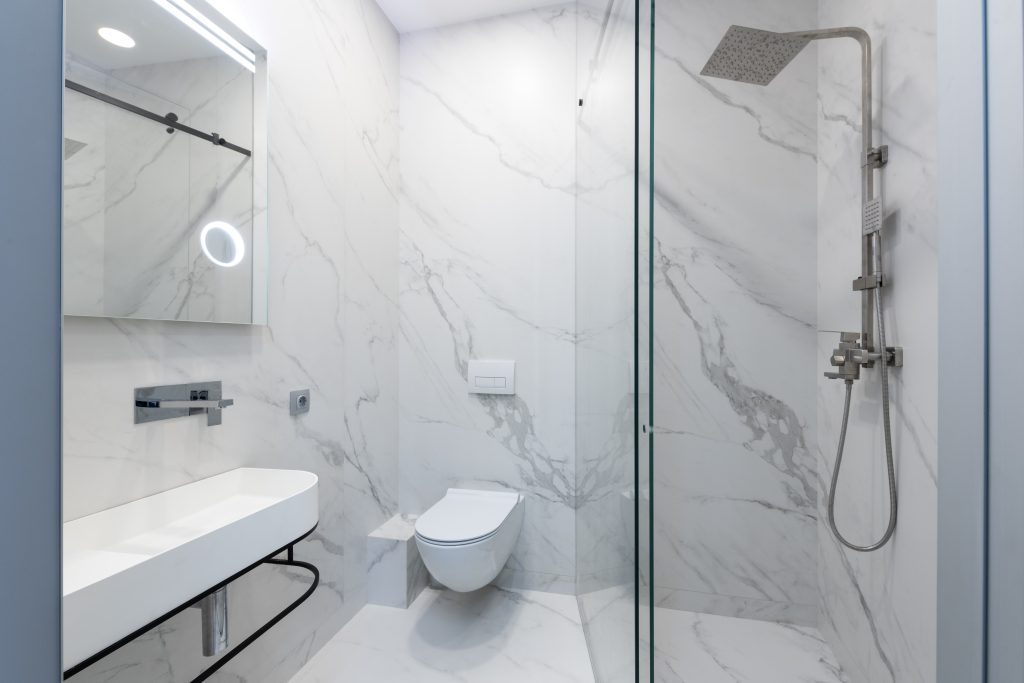There are many options for updating a shower. Some ideas include a linear niche and a glass panel. It’s important to keep the shower clean. This will help prevent soap scum and mildew build-up.
The new shower membrane technology is called an “undertile” waterproofing membrane. It eliminates the need for a separate shower pan. This technology comes in a sheet that can be applied to tile backer boards and shower bases. Even affordable shower repair solutions can help you upgrade your shower to modern standards.
Water-Resistant Substrate
A shower needs a substrate that is both water-resistant and strong enough to support the tile. In old systems, this meant a paper or plastic vapor retarder stapled to the studs and then cementboard over it, all of which can be quite porous. Over time, this allows water and steam to penetrate the wallboard and cause damage to framing members.
A modern system starts with a presloped foamboard shower pan, which is rabbeted (cut in the corners to accept wall panels) and bonded to the subfloor with thinset mortar. A polyethylene sheet waterproofing membrane is then laid over the substrate and troweled with a special sealant to ensure the substrate is completely covered. The waterproofing is also used to seal the rabbets and around all penetrations. Many of these systems come with preformed inside and outside corners and seam tape to ensure 2-in. overlaps, making them much faster to install than traditional methods.
Once the substrate is in place, the installation of the walls is very similar to a standard wall, with drywall or green board up to the shower. However, this board must be water-resistant and there are many different types available. Drywall is not suitable as a wall tile backer board, as it can disintegrate in the presence of moisture. A better alternative is gypsum board that has been specifically treated for use in a damp environment or a product like DensShield Backer Board. OSB and plywood are other viable options, but they should be especially water-resistant and treated for a damp environment as well.
Shower niches and built in benches should also be waterproofed with a liquid membrane that is applied to the entire surface of the wall. It is important that all external and internal corners, joints and penetrations are waterproofed as well.
A new generation of liquid waterproofing products is now available that do not require the use of primers, saving both time and materials on the job site. They also do not contain any solvents, which is an advantage for the environment as well as for the installers. These innovative solutions provide a high level of waterproofing, while protecting the substrate and providing a solid surface for installing tile.
Water-Resistant Tile
As the saying goes, “an ounce of prevention is worth a pound of cure.” And nowhere is this more true than in your shower. Spills, splashes and unexpected leaks can cause serious problems, including rotting floor framing and mold. But tile is built to resist moisture and, if properly installed, forms a waterproof system that will last a lifetime.
When you are installing a new tile shower, a waterproofing membrane is always needed underneath the tile. This membrane prevents bulk water from seeping through the tiles into the substrate. That moisture could then rot the framing and cause mold and mildew. The best products for this job include liquid membranes like Redgard and sheet membranes such as Durock or NobleSeal TS that are applied directly to the backer board surface. These membranes are usually plastic or elastomeric and have to be bonded to the substrate with a special waterproof adhesive. These membranes are also typically textured, which helps to grip the thin-set and improve its water-resistance.
To install these products, you’ll need to prime the surface before bonding to it. You’ll also need to seal the corners of the membrane with waterproof sealing tape. After that, you can apply a layer of thin-set and set your wall and shower floor tile as usual. It’s important to use a high-quality, wet-area tile and to ensure that the thin-set has complete and even coverage on the membrane.
Another important step is to remove the plastic vapor retarder sheets that were sometimes used on the outside of the shower stall in older homes. This is important because those sheets trap the moisture inside the stud cavity. When this moisture evaporates, it can rot the framing or create a condensation problem in your house that causes mold and mildew and makes the home harder to heat. Using the low perm waterproofing membrane mentioned above, you can eliminate this problem by making sure that only one layer of waterproofing is used on the exterior walls of your shower stall.
Water-Resistant Grout
Typically, standard grout (sanded or unsanded) will absorb water and other liquids unless it is protected with a good sealer. This can lead to mold, mildew and other unpleasantries in your shower.
Grout sealer is an important part of the tiling installation process and should be used on most projects. It is a simple way to help keep your grout from absorbing water, which makes it more stain-resistant and easier to clean.
When a tile is installed the grout has to be packed in tightly and correctly to ensure that there are no spaces between the tiles where moisture can get in. If the grout is not properly packed, it will leave gaps behind the tiles where it can easily leak and cause damage to the substrate underneath the tile. Having a high-quality and well-mixed grout, along with proper application techniques can help to make sure that the gaps are filled in and no water can get in through them.
Cement-based grout is highly porous and will readily absorb water if it is not sealed. It also stains easily and can deteriorate over time, allowing water to penetrate under the tiles.
A special type of grout that is both waterproof and stain-resistant is called epoxy grout. It is a little more expensive than sanded or unsanded grout but it will last much longer and is a lot easier to maintain. Epoxy grout is available in a wide variety of colors so you can find a shade that works with your project.
If you have an older home that has been renovated, a good quality waterproof membrane might be the best way to protect your shower from water penetration and damage. These membranes not only provide an extra barrier of protection to the concrete liner, but they will isolate the tile from the framing studs so that moisture does not wick through and rot them like it can do to standard drywall.
I always recommend having a plumber test your old shower to ensure it is waterproof before you move in or start using it. It only takes a few minutes to do and can save you a lot of grief in the future.
Water-Resistant Finish

Waterproof finishes seal wood to keep moisture from getting into the pores of the material. These finishes can be synthetic resins bonded to drying oils, such as linseed oil or polyurethane, or natural processed oils, like tung oil. Oil-based varnishes top the durability charts for waterproof finishes, but they require a lot of time to dry and cure. They also produce toxic fumes when being applied and need to be thinned with a solvent like turpentine or mineral spirits. To meet government regulations for lower volatile organic compound (VOC) emissions, manufacturers have been reducing the amount of thinner in their finishes.
Aside from its use in workwear, water-resistant finish fabrics are also used in the healthcare and housekeeping sectors. In fact, these fabrics are so popular that they have grown to be a common fabric for protective suits and coats for medical personnel. To test the water-repellency of a fabric, sprinkle a little water on it and see how it reacts. If the water rolls on the surface it means the fabric has W.R. The opposite is true for waterproof fabric – if the water soaks in and doesn’t come out it has been treated with W.P.
In the construction of tiled showers, a new waterproofing method has been developed that eliminates the need for a separate drainage pan beneath the shower base. This system bonds a shower drain to an under-tile membrane and creates an elegantly simple and far more effective shower structure than the old-fashioned pan/mud-bed approach.
When properly installed, this system allows the substrate to expand and contract with fluctuations in humidity without affecting the framing. The insulated under-tile membrane also prevents moisture from leaking between the shower wall and framing, which could rot the wood.
Another new innovation in shower construction is preformed shower niches. These come as a sealed waterproof box that is mounted in the shower wall. This eliminates the need for a waterproofing membrane within the niche and makes it much easier to install than a custom niche. However, when mounting a niche in the wall, it is important to ensure that the niche doesn’t interfere with plumbing or electrical wires behind the walls.




